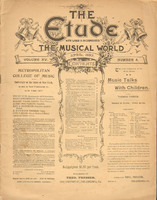Selected Content from the April 1897 Edition of The Etude
“It is an undisputed fact that many people associate tone with color. As is always the case, this sense of perception is more acute in some than in others.” Read More
Even after a pupil has been thoroughly prepared in foundational work, he will find he has learned but little in this distinctively beautiful art of piano playing. For let him take a simple “Song without Words” from Mendelssohn, and attempt to play it before one of Leschetizky’s artist Vorbereiter, he will be surprised at being stopped at the end of the first or second measure. Read More
People ought to prepare themselves for Wagner in a literary way—read the “Nibelungen Lied” in translation, if in no other way, or study librettos—before trying to understand heroic love and soul tragedies sung in a foreign language conveyed by tonal progressions unfamiliar and startling to the novice. Read More
To avoid any misunderstanding, it may be best to state right here that freaks are not under discussion; microcephalæ, idiots,* pitch-deaf children, analogies to color blindness; malformed arms and fingers are not “interesting,” but impossible. But the common, ordinary “backward pupil,” with whom there is nothing the matter, except that he or she doesn’t “get on,” is a most interesting subject Read More
It is a pleasure to observe what an increasing amount of attention periodical literature is giving to music. The popular and standard magazines are competing with one another in their articles about our art. The daily and weekly papers are giving more and more space to musical affairs, and even some college professors brag about not “knowing one tune from another” less than formerly. Read More
Mozart wrote to a pitch of C=508, which would make the high “G’s” in the Gloria of the Twelfth Mass equivalent to a note about half way between F and F sharp at C=546—an immense relief to the average chorus. Handel, Bach, Haydn, Mozart, Beethoven, and Schubert all wrote for C=498 to 515; so when we sing their music at the high concert pitch, we actually transpose it from a minor to a major second higher than the pitch the composers intended it to be sung at. The movement toward a low pitch is, therefore, a step in the right direction. Read More
Notices for this column inserted at 3 cents a word for one insertion, payable in advance. Copy must be received by the 20th of the previous month to insure publication in the next number. WANTED-POSITION AS PIANO TEACHER INConservatory or… Read More
EDOUARD REMENYI, the violinist, is giving concerts in the South. Miss NEALLY STEVENS, the accomplished pianist, is giving farewell recitals in California. CHAS. KLEIN and John Philip Sousa are well advanced on their new opera, “The Bride Elect.” THE Minneapolis… Read More




